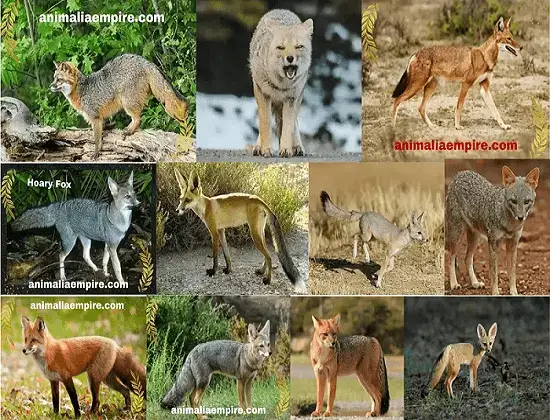You may have come across many different types of foxes in literature, media, and art, even though if you haven’t seen it. There are many stories, paintings, and movies featuring foxes like animals as characters.
Some popular examples of all foxes types in media include the character of Mr. Fox in the children’s book “Fantastic Mr. Fox,” the character of Reynard the fox in European folklore, and the character of Fox Mulder in the TV show “The X-Files.”
Foxes are known for their sly and cunning behavior, and they have been depicted in many different cultural traditions as tricksters and shape-shifters. Breeds of foxes are divided in different genera on the base of various habits such as;
- Diet: Different type of foxes may have different dietary preferences and may hunt different types of prey.
- Habitat: Foxes can be found in a variety of habitats, including forests, grasslands, deserts, and urban areas. Different species of foxes may be adapted to living in specific types of habitats, such as the Arctic fox, which is adapted to living in cold, snowy environments, or the fennec fox, which is adapted to living in the desert.
- Social behavior: Foxes are social animals that live in small groups called “packs,” which consist of a breeding pair and their offspring. Different species of fox may exhibit different social behaviors, such as living in larger or smaller groups, or being more or less territorial.
- Behavior: Different species of foxes may exhibit different behaviors. For example, some breeds of foxes are known for their vocalizations, while others are more solitary and less vocal.
How many Types of foxes are there in the world?
Foxes are carnivorous mammals that belong to the family Canidae, which also includes wolves, dogs, and jackals. All types of foxes are found on every continent except Antarctica. There are almost 37 types of foxes, fox species of 6 genera exist worldwide. Some species are extinct and few are nearly threatened, conservation efforts are underway to preserve the unique species.
Foxes belong to the genus “Vulpes” which includes 12 true fox species of foxes (types of foxes), and this is the largest fox genus in family Canidae, while “Lycalopex“ is 2nd largest fox species group.
| Kindom | Animalia |
| Phylum | Chordata |
| Class | Mamalia |
| Order | Canivora |
| Family | Canidae |
| Genus | i. Vulpes ii. Lycalopex iii. Canis iv. Cerdocyon v. Otocyon vi. Urocyon |
List of Foxes Types
There are many different foxes breeds, and they can be found in a variety of habitats around the world. Some common types of foxes found around the world include:
| Genera | Fox species name |
| Vulpes | i. Arctic fox ii. Blanford’s fox iii. Corsac fox iv. Kit fox v. Rüppell’s fox vi. Swift fox vii. Tibetan sand fox viii. Bengal fox ix. Cape fox x. Fennec fox xi. Pale fox xii. Red fox |
| Lycalopex | i. Darwin’s fox ii. Hoary fox iii. Pampas fox iv. Sechuran fox v. South American gray fox vi. Culpeo or Andean fox |
| Canis | i. Ethiopian wolf, or Simien fox |
| Cerdocyon | i. Crab-eating fox |
| Otocyon | i. Bat-eared fox |
| Urocyon | i. Gray fox ii. Island fox iii. Cozumel fox |
| Dusicyon | Extinct genus, including the Falkland Islands wolf, sometimes known as the Falklands Islands fox |
Classification and Description of Foxes
Foxes are often divided into two main categories:
True foxes, which belong to the genus Vulpes, This category includes the most common types of foxes, such as the red fox, arctic fox, and gray fox. These foxes have similar physical characteristics, such as a pointed snout, triangular ears, and a bushy tail.
False foxes, which belong to the genus Urocyon, This category includes the gray fox, island fox, and other fox-like animals that have evolved in isolation in specific regions. These animals have similar features to true foxes but have some anatomical and behavioral differences that set them apart.
Red foxes are the most widely distributed species of fox. Other different kinds of foxes include the Kit fox, the Swift fox, and the bat-eared fox.
The following is a description of all the various types of foxes that are included in the aforementioned list.
Genus Vulpes
Arctic Fox (V. lagopus)
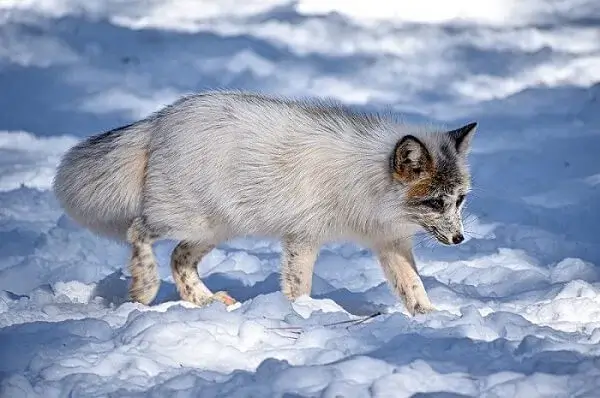
Distribution: The Arctic fox is a small carnivorous mammal native to the Arctic regions of the Northern Hemisphere
General characters: This types of fox is well adapted to living in cold environments, with thick fur, a small rounded body, and short legs.
In the winter, the Arctic fox’s coat turns white to blend in with the snowy surroundings, while in the summer it turns a brownish-gray color. This seasonal change in coat color, known as “pelage,” helps the fox to camouflage itself and avoid predators.
Arctic foxes are the breed of foxes that show social animals and live in large family groups, with complex social hierarchies. They mate for life and have a high reproductive rate, with litters of up to 11 pups being common
Conservation: The Arctic fox population is currently in decline due to habitat loss and other human-related activities.
Blanford’s fox (V. cana)

Distribution: Blanford’s fox, also known as the Afghan fox or the Indian fox, is a small carnivorous mammal native to the arid regions of western and central Asia. Blanford’s foxes are found in several countries in western and central Asia, including Afghanistan, Iran, Iraq, Pakistan, and Turkmenistan.
General characters: This types of foxes species named after the British zoologist William Thomas Blanford. Fox breed Blanford’s fox is around the size of a domestic cat, with a body length of around 45 cm and a weight of around 1.5 kg. It has a reddish-brown coat with white under parts and fox with spots, black spots appear on its face, tail, and legs. Its long and pointed ears are typically black on the outside and white on the inside.
Blanford’s species of a fox adapted to living in desert and semi-desert environments, with a preference for rocky and hilly terrain. They are nocturnal animals and are known to be very agile and fast runners.
Conservation: This kind of fox animal is considered to be endangered due to habitat loss and hunting for their fur.
Corsac fox (V. corsac)

Distribution: The Steppe fox, also known as the corsac fox, is a species of fox native to the grasslands of Central Asia.
General characters: They are small fox breed than other fox species, with a reddish-brown coat and a distinctive white patch on their chest. They are known for their high levels of intelligence and are skilled hunters, preying on small rodents and insects. They are also known to be adaptable, able to survive in a variety of environments and climates.
Conservation: Corasc fox breeds are considered vulnerable to extinction due to habitat loss and hunting.
Kit fox (V. macrotis)

Distribution: The kit fox is a small fox species, and carnivorous mammal native to the southwestern United States and northern Mexico.
General characters: It is a member of the fox family and closely related to the gray fox. Kit foxes are about the same size as a domestic cat and have a slender build with large ears, a pointed muzzle, and a long, bushy tail. They have a sandy or reddish-gray coat with black spots on the ears and tail.
Kit foxes are adapted to living in arid environments, and they are found in a variety of habitats including deserts, grasslands, and scrublands.
Kit foxes are solitary fox in wild and live in underground dens, which they may share with a mate or family group. They are territorial animals and use vocalizations, scent marking, and physical displays to communicate and defend their territory.
Conservation: Habitat loss and degradation, as well as accidental mortality due to vehicle collisions and poisoning, can pose challenges for the species. Conservation efforts are underway to protect and manage kit fox populations in the United States and Mexico.
Rüppell’s fox (V. rueppelli)

Distribution: Rüppell’s fox is a small species of a fox, native to the Horn of Africa and the Arabian Peninsula. This fox species named after the German naturalist Eduard Rüppell, who first described the species in the early 1800s. Rüppell’s foxes are found in a variety of habitats, including desert, grassland, and mountain areas.
General characters: These are omnivorous kinds of foxes animal, feeding on a wide range of plants and animals, including insects, and berries. They are typically active at dawn and dusk, and are known for their ability to dig deep burrows for shelter.
Conservation: Rüppell’s foxes are listed as Near threatened on the IUCN Red List, due to habitat loss and degradation.
Swift fox (V. velox)

Distribution: The swift fox is a small species of fox native to the Great Plains of North America. It is one of the smallest fox species, with an average length of about 50 cm and a weight of only 1.5 kg. all foxes of this genus have reddish-brown fur, a white belly fox with spots in black color on the face and legs.
General characters: Swift foxes eat a variety of food including insects, small rodents, fruits, and plants. They are most active at dawn and dusk, and are known for their high-speed chases after prey. They are also good climbers and swimmers.
Swift foxes are social animals and live in small family groups called packs. They mate for life and females give birth to litters of up to six pups.
Conservation: Swift foxes were once found throughout the Great Plains, but their populations have declined due to habitat loss, hunting, and trapping. They are now listed as a threatened species in some states and are protected by law. Conservation efforts, including reintroduction programs, have helped to increase their numbers.
Tibetan sand fox (V. ferrilata)

Distribution: The Tibetan sand fox is a small fox breed that is native to the Tibetan Plateau in China.
General characters: Breed of fox is adapted to living in cold, dry environments and can be found at elevations up to 5,000 meters (16,400 feet). The Tibetan sand fox has a distinctive appearance, a weird looking fox with a reddish-brown coat, a white underbelly, and black ear tips. It has a small, slender body and long, thin legs. The Tibetan sand fox is nocturnal and feeds on small mammals, and lagomorphs.
Conservation: This type of foxes are classified as a Least Concern (LC) species by IUCN, as it has a wide distribution and is not currently facing any major threats.
Bengal fox (V. bengalensis)
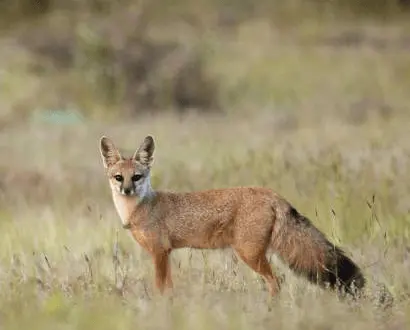
Distribution: The Bengal fox, also known as the Indian fox, is a small fox species native to the Indian subcontinent. It is found in a variety of habitats, including grasslands, scrublands, and agricultural areas.
General characters: The Bengal fox type has a reddish-brown coat, a white underbelly, and black ear tips. It is generally smaller than other fox species, with a body length of about 50-60 cm and a tail length of about 35-45 cm. The Bengal fox is omnivorous, social animal, and feeds on a variety of prey, including rodents, birds, insects, and fruit.
Conservation: The Bengal fox is classified as a LC species by the IUCN due to its wide distribution and stable population.
Cape fox (V. chama)

Distribution: The Cape fox is a small fox breeds native to Southern Africa. It is found in a variety of habitats, including grasslands, savannas, and wooded areas.
General characters: The Cape fox has a reddish-brown coat and a white underbelly, and its ears are large and pointed. It is generally smaller than other fox species, with a body length of about 40-50 cm and a tail length of about 30-35 cm. The Cape fox feeds on a variety of prey species, and a rarer fox species.
Conservation: The Cape fox is classified as a LC species by the International Union for Conservation of Nature due to its wide distribution and stable population.
Fennec fox (V. zerda)
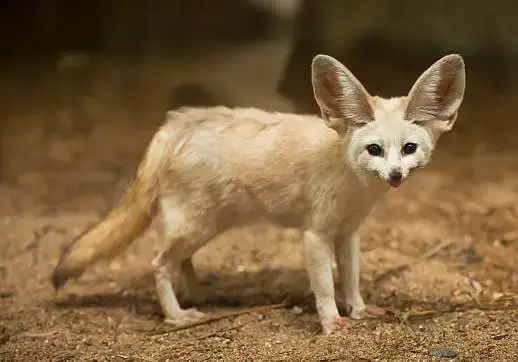
Distribution: The fennec fox is a small fox species native to the Sahara Desert in North Africa. It is adapted to living in hot, dry environments and can be found in a variety of habitats, including sand dunes, rocky outcrops, and grasslands.
General characters: The fennec fox is easily recognizable due to its small size and distinctive appearance. It has a sandy-colored coat, large ears, and a pointed snout. This type of fox is nocturnal and primarily feeds on small species, such as insects, and rodents. This kind of breeds shows social behavior, and lives in small family.
Conservation: Fennec fox breed of foxes classified as a LC species by the IUCN, as it has a wide distribution and is not currently facing any major threats.
Pale fox (V. pallida)

Distribution: The pale fox is a small fox species native to the Sahel region of Africa, which stretches from Mauritania to Sudan. this type of fox is found in a variety of habitats, including savannas, grasslands, and wooded areas.
General characters: The pale fox has a pale-colored coat, with a white underbelly and black ear tips. It is generally smaller than other fox species, with a body length of about 40-50 cm and a tail length of about 30-35 cm. The pale fox’s breeds are omnivorous and feed on a variety of living organisms.
Conservation: The pale fox is also classified as a LC species by the IUCN due to its stable population.
Red fox (V. vulpes)

Distribution: The red fox is native to a large portion of the Northern Hemisphere, including most of North America, Europe, and Asia.
General description: It is one of the most widespread and well-known fox species, and it is known for its reddish-brown coat, white underbelly, and black ear tips. The red fox is found in a variety of habitats, including forests, grasslands, and urban areas.
Conservation: It is classified as a LC species by IUCN due to its wide distribution and stable population.
Genus Lycalopex
(South American species)
Darwin’s fox (L. fulvipes)
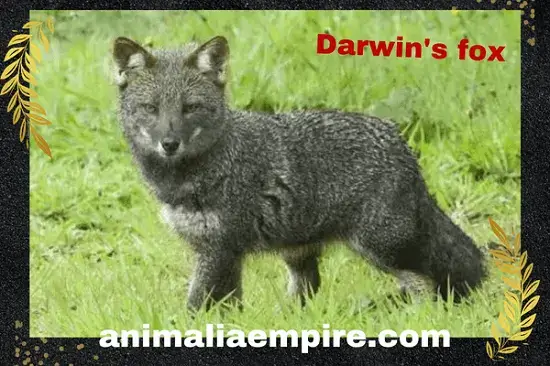
Distribution: Darwin’s fox also known as the Darwin’s zorro or the zorro de Darwin, is a small carnivorous mammal native to Chile and Argentina. It is named after Charles Darwin, who collected specimens of the species during his voyage on the HMS Beagle in the 1830s.
General characters: Darwin’s fox is a member of the Canidae family, which also includes wolves, dogs, foxes, and jackals. It is a type of foxes in South American gray fox (L. griseus), but is smaller in size, with a more slender build and a longer, bushier tail.
Darwin’s fox is found in the temperate rainforests of southern Chile and Argentina, where it lives in dense, humid forests and feeds on small species. It is a solitary and nocturnal species, and is thought to be an important seed disperser in its habitat.
Conservation: Darwin’s fox is considered to be an endangered species, with a population of only a few thousand individuals. It is threatened by habitat destruction, hunting, and disease. Efforts are being made to protect and conserve this species, including the creation of protected areas and the implementation of conservation programs.
Hoary Fox (L. vetulus)
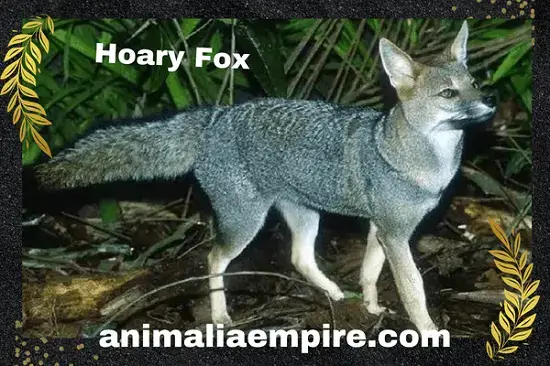
Distribution: The hoary fox is a small carnivorous mammal native to South America. The hoary fox is found in open grassland and savanna habitats in Brazil, Paraguay, Bolivia, and Argentina.
General characters: The hoary fox has a distinctive appearance, with a reddish-gray coat that is lighter on the underside and a black stripe running down the back. It has large ears and a long, bushy tail. It is a solitary and nocturnal species, and feeds on small mammals, and fruit.
Conservation: The hoary fox is not considered to be a threatened species, and its population is thought to be stable. However, it is vulnerable to habitat destruction and hunting, and efforts are being made to protect and conserve this species in certain areas.
Pampas fox (L. gymnocercus)

Distribution: The pampas fox also known as the South American gray fox or the Argentine fox, is a species of fox native to South America. It is found in the pampas and grasslands of Argentina, Brazil, Paraguay, and Uruguay.
General characters: It is closely related to the Darwin’s fox (L. fulvipes), and is similar in size and appearance, with a slender build, a long, bushy tail, and a grayish-brown coat. All kinds’ of foxes in this species are omnivorous; feed on small species, birds, and fruit. It is a solitary and nocturnal animal, and is known to be an important seed disperser in its habitat.
Conservation: The pampas fox is not considered to be threatened, and has a relatively stable population. It is impacted by habitat loss and hunting, and is considered to be vulnerable in some areas.
Sechuran fox (L. sechurae)
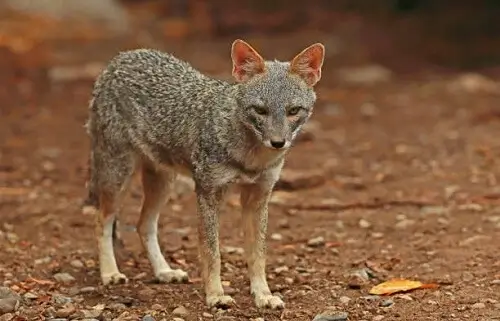
Distribution: The Sechuran fox also known as the Sechuran zorro or the zorro sechurano, is a small carnivorous fox species native to the Sechura Desert in Peru and Ecuador.
General characters: The Sechuran fox is closely related to other South American foxes, such as the Darwin’s fox (L. fulvipes) and the South American gray fox (L. griseus). It is small in size, with a body length of about 35-45 cm and a tail length of about 25-30 cm. It has a sandy-colored coat with a black tip on its tail and black patches on its ears.
The Sechuran fox is adapted to living in desert environments, and is able to survive in these harsh conditions by foraging for food at night and seeking shelter during the day. It feeds on a variety of prey, including small mammals, reptiles, and insects.
Conservation: Like other fox species, the Sechuran fox is considered to be at risk from habitat loss and other human activities. It is listed as “near threatened” on the IUCN, Red List of Threatened Species. Efforts are being made to protect and conserve this species, including the creation of protected areas and the implementation of conservation programs.
South American gray fox (L. griseus)

Distribution: The South American gray fox, also known as the Patagonian fox or the chilla, is a species of fox found in the southern regions of South America, including Argentina, Chile, and Peru. The South American gray fox is adapted to life in a variety of habitats, including forests, grasslands, and deserts.
General characters: This breed of fox is small to medium-sized, with a body length of around 50 cm and a weight of up to 4 kg. The South American gray fox has a gray or reddish-gray coat, with a white belly and a black stripe running down the back. It has a long, bushy tail and medium size pointed ears.
Conservation: The South American gray fox is considered to be a vulnerable species due to habitat loss and persecution by humans. It is protected by law in some countries, and conservation efforts are underway to help protect and preserve this unique and fascinating species.
Culpeo fox (L. culpaeus)

Distribution: The culpeo or Andean fox is a species of fox found in the Andes Mountains and other parts of South America, including Argentina, Chile, Peru, and Bolivia.
General characters: It is a medium sized fox, with a body length of around 65 cm and a weight of up to 7 kg. The culpeo has a reddish-brown or yellowish-gray coat, with a white belly and black fur on the legs and tail. It has large, pointed ears and a long, bushy tail.
The culpeo is adapted to life in a variety of habitats, including forests, grasslands, and deserts, and is found at altitudes ranging from sea level to over 4,000 meters.
Conservation: It is considered to be a least concern species by the IUCN, as it is widespread and common throughout its range. However, it is subject to some threats, including habitat loss and persecution by humans.
Genus Canis
Ethiopian wolf or Simien fox (C. simensis)
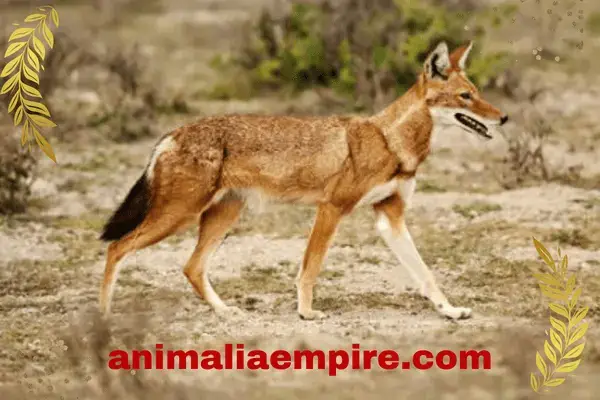
Distribution: The Ethiopian wolf, also known as the Simien jackal or Simien fox, is a species of canid found in the highlands of Ethiopia. It is the only species of wolf found in Africa, and it is one of the rarest fox, and most endangered foxes of the world.
General characters: The Ethiopian wolf is a medium-sized species, with a body length of around 70 cm and a weight of up to 20 kg. It has a reddish-brown coat, with a white belly and black fur on the legs and tail. It has large, pointed ears and a long, bushy tail.
The Ethiopian wolf is adapted to life in cold, high-altitude environments, and it is found at elevations ranging from 3,000 to 4,500 meters. It is a carnivorous species, feeding primarily on rodents and other small fox like animals.
Conservation: This rare fox breed is classified as endangered by the IUCN due to habitat loss and persecution by humans. Conservation efforts are underway to help protect and preserve this unique and threatened species.
Genus Cerdocyon
Crab-eating fox (C. thous)

Distribution: The crab-eating fox, also known as the forest fox, crab-eating dog, or painted fox, is a species of fox found in a variety of habitats throughout much of South America, including forests, savannas, and grasslands.
General characters: It is a medium-sized fox, with a body length of around 60 cm and a weight of up to 7 kg. The crab-eating fox has a reddish-brown coat, with a white belly and black fur on the legs and tail. It has large, pointed ears and a long, bushy tail.
Conservation: This breed of foxes is considered to be a least concern species by the IUCN, as it is widespread and common throughout its range. Conservation efforts are underway to help protect and preserve this unique and fascinating species.
Genus Otocyon
Bat-eared fox (O. megalotis)
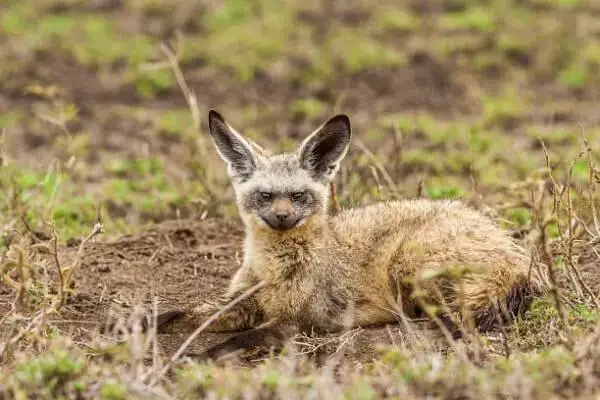
Distribution: The bat-eared fox is a species of fox found in the grasslands and savannas of eastern and southern Africa.
General characters: Small to medium-sized fox, with a body length of around 50 cm and a weight of up to 5 kg. The bat-eared fox is named for its distinctive large, bat-like ears, which are used for hearing the movements of insects, its primary food source.
O. megalotis is fox breed has a pale gray or yellowish-brown coat, with a white belly and black fur on the legs and tail. It has a long, bushy tail and very large bat type pointed ears. The bat-eared fox is a nocturnal species, spending the day in underground dens and emerging at night to hunt insects.
Conservation: The bat-eared fox is classified as a least concern species by the IUCN, as it is widespread and common throughout its range. Conservation efforts are underway to help protect and preserve this unique and fascinating species.
Genus Urocyon
(North American Species)
Gray fox (U. cinereoargenteus)

Distribution: The gray fox is a species of fox found in a variety of habitats throughout much of North and Central America. It is a medium-sized fox, with a body length of around 80 cm and a weight of up to 7 kg.
General characters: The gray fox has a gray or reddish-gray coat, with a white belly and black fur on the legs and tail. It has a long, bushy tail and large, pointed ears. The gray fox is unique among North American carnivores in that it is able to climb trees, using its sharp claws and flexible ankles to ascend trunks and branches.
Conservation: It is considered to be a LC species by the IUCN, as it is widespread throughout its range. However, it is subject to some threats, including habitat loss and persecution by humans. Conservation efforts are underway to help protect and preserve this fascinating species.
Island fox (U. littoralis)

Distribution: The island fox is a small species of fox found on six of the eight Channel Islands of California. It is a subspecies of the gray fox (U. cinereoargenteus), and it is the small fox like animal.
General characters: This fox breed is quite similar to the type of foxes in North America, with a body length of around 45 cm and a weight of up to 2 kg. The island fox has a gray or reddish-gray coat, with a white belly and black fur on the legs and long, bushy tail with pointed ears.
The island fox is adapted to life on the islands, and it is found in a variety of habitats, including forests, grasslands, and coastal areas.
Conservation: It is considered to be a vulnerable species by the IUCN, as it is threatened by habitat loss and persecution by humans. Conservation efforts are underway to help protect and preserve this unique and threatened species.
Cozumel fox (U. avius)

Distribution: The Cozumel fox is a small species of fox found on the island of Cozumel, off the Yucatan Peninsula in Mexico. It is a subspecies of the gray fox (Urocyon cinereoargenteus) and is similar in appearance to other gray foxes, with a gray or reddish-gray coat, a white belly, and black fur on the legs and tail. It also has a long, bushy tail and pointed ears.
General characters: The Cozumel fox is adapted to life on the island and is found in a variety of habitats, including forests, grasslands, and coastal areas. It is an omnivorous species, feeding on a variety of small animals, fruit, and insects.
Conservation: The Cozumel fox is considered to be a vulnerable species by the IUCN due to habitat loss and persecution by humans. Conservation efforts are underway to help protect and preserve this threatened species.
Nor Fox Nor Wolf

Maned wolf (Chrysocyon brachyurus) is a largest fox-like as well as wolf-like animal among South American species; this fox like animal have many similar characteristics to the canid species wolf. But it is considered as individual species as it is nor wolf nor fox.
New types of fox species
Sierra Nevada
There have been several new species of foxes discovered in recent years. For example, in 2020, scientists announced the discovery of a new rare fox species Sierra Nevada a small group of rear fox in the wild, and Mountains of California.

The Sierra Nevada red fox (V. vulpes necator) had previously been thought to be a subspecies of the red fox (V. vulpes), but genetic analysis revealed that it is a distinct species.
Cat fox:
Wildlife experts of Corsica have found a peculiar “cat-fox” that may be a brand-new species. A rarest fox species “cat-fox” that had been discovered in Corsica’s Asco Forest.

The species, which is around 35 inches long from animal head to tail, is described as having “extremely broad” ears, “well developed” canines, and short whiskers. The animal has a thick coat as well as dark hind legs and front legs with stripes.
There is still much that is unknown about the “cat-fox,” including its food, reproductive habits, and origins. Experts claim that the species is distinct from the common European wildcat, and it is thought that the breed originate in the Middle East. This type of fox is still not classified.
Bottom line
In short, there are different types of foxes that are found around the world, including the red fox, arctic fox, fennec fox, gray fox, kit fox, swift fox, and pale fox. Each species has its own unique physical characteristics and adaptations that help it survive in its particular habitat. Foxes are intelligent, adaptable animals that are found in a variety of environments, including forests, grasslands, and deserts. They are omnivorous, eating both plants and animals, and they are known for their keen senses and agility.

